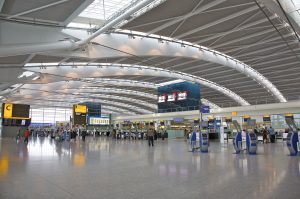In the wake of the COVID-19 pandemic, many service industries are reevaluating their physical footprint, and the aviation industry is no exception. Opportunities abound for developers, designers, and contractors to update and expand airport terminals to accommodate traditional needs while also meeting the growing demand for more open space (including larger outdoor areas in terminals and larger cargo facilities to meet the needs of Amazon, FedEx and UPS).
The Future of Passenger Terminals
In nearly every service industry, safety and hygiene policies are being overhauled, with a specific emphasis on the desire for more space across the board. Even before the pandemic caused a seismic shift in the way individuals interact with each other, airports and airlines had started reducing the number of unnecessary interactions between travelers and employees by introducing self-service check-in kiosks and contactless ordering at restaurants. The automation inside the airport will only continue to advance.
But the biggest challenge in a post-pandemic world remains the need for space—space between travelers, space for fresh air, space to implement new technology designed to keep everyone healthy. So, what does that mean for airports, who due to their placement in and around large cities, generally have a limited physical footprint to begin with? Flexibility and adaptability—two terms that have defined the human experience of COVID-19—will lead the charge to meet the needs of airport infrastructure, particularly where expansion may not be feasible. Space previously dedicated to the industry of the past, like ticket counters now long abandoned for online check-in, provide an excellent opportunity for redevelopment.
Even those airport construction projects that have been cleared for takeoff may want to consider adapting their existing plans to the changing needs of passengers and the industry as a whole. Pittsburgh International Airport, for example, was recently given the green light to initiate its overhaul, marking the first airport terminal designed with a post-pandemic world incorporated right into its designs. Upgrades include large outdoor gardens in between terminal buildings, tall ceilings, and large windows to create the appearance of more space.
The Future of Cargo Terminals
The need for space exists outside of the passenger terminal, too. While leisure travel plummeted during the pandemic, cargo was, and continues to be, a financial lifeline for the aviation industry. Demand for air cargo services from shipping companies like Amazon, FedEx, and UPS are at an all-time high and will no doubt continue to grow as e-commerce leads the consumer experience.
The constantly increasing demand for cargo services within the airport will also increase the real estate opportunities for properties surrounding airports. Facilities are needed to store temperature and time-sensitive goods like pharmaceuticals. Warehouses close by are needed to offload goods destined for consumers across the country. Hotels and restaurants are needed to service the individuals handling cargo.
Whether the aviation industry, and surrounding infrastructure, focuses on the inevitable return to full capacity passenger service, or the ever-growing demand for consumer goods, real estate developers, designers, and contractors have an exciting opportunity to meet this increased demand for space across the board.
 Gravel2Gavel Construction & Real Estate Law Blog
Gravel2Gavel Construction & Real Estate Law Blog



